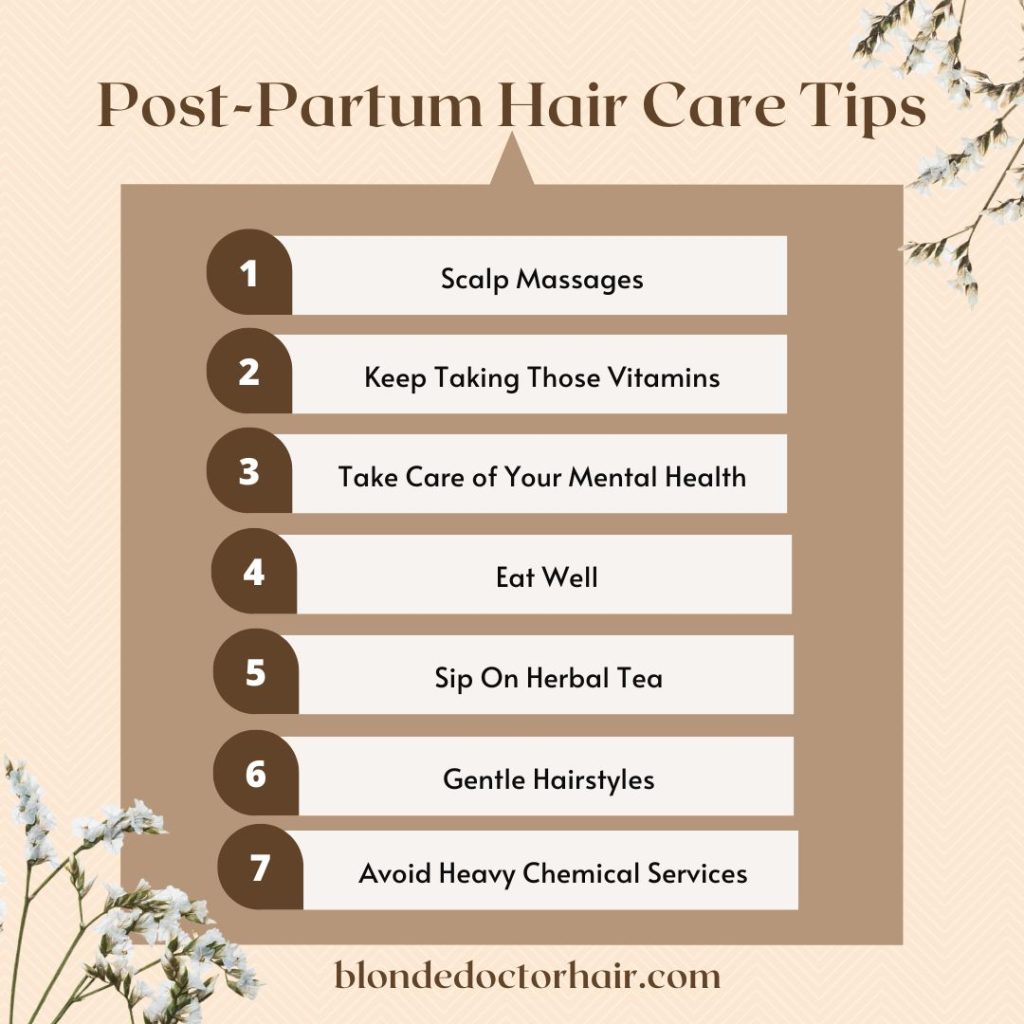The Postpartum Hair Loss Panic – Keep Calm and Grow On


Bringing new life into the world is a miraculous experience, but it can also bring unexpected changes to your body—like postpartum hair loss. This temporary condition, also known as telogen effluvium, is something many new moms experience around three to six months after giving birth. Curious about why it happens and how you can handle it with a little less stress? Let’s read on, shall we?!
What is Postpartum Hair Loss?
During pregnancy, elevated hormone levels, particularly estrogen, keep your hair in the growth phase longer, resulting in thicker, fuller hair. But after your baby arrives, hormone levels return to normal, and more hairs enter the resting (telogen) phase. This shift leads to increased shedding and noticeable thinning, but don’t panic – it’s temporary.

Why Does Postpartum Hair Loss Happen?
A mix of hormonal changes, the physical stress of childbirth, and shifts in nutrient levels can cause postpartum hair loss. These factors disrupt the hair growth cycle, leading to more shedding. It can be alarming, but it’s a natural and temporary process as your body adjusts post-pregnancy.
What is Considered Normal Hair Loss?
Normally, you might lose between 75 to 100 hairs a day. During postpartum shedding, this number can increase. Hair loss usually peaks around three to four months after giving birth and tapers off within six to twelve months.
How Can You Help Yourself?
While you can’t completely prevent postpartum hair loss, there are plenty of ways to support healthy hair growth and lessen its impact:
- Scalp Massages – Massaging your scalp can boost blood circulation to your hair follicles and promote growth. For an added benefit, use nourishing oils like coconut or almond oil. Try massaging your scalp for a few minutes each day to wake up those follicles. See my article about hair oiling here.
- Keep Taking Those Vitamins – Keep up with your prenatal vitamins or switch to a hair supplement postpartum. Look for biotin, vitamins A, C, D, and E, zinc, and iron to keep your hair happy and healthy
- Take Care of Your Mental health – Stress can contribute to hair loss, so it’s important to manage it. Yoga, meditation, or chatting with a therapist can help you navigate the emotional ups and downs of postpartum life. Easier said than done, I know.
- Eat Well – A balanced diet rich in vitamins and minerals, especially iron, zinc, and vitamin D, can support hair growth. Load up on leafy greens, eggs, fish, nuts, and seeds.
- Sip Some Herbal Teas – Herbal teas made from fenugreek, fennel, and cumin seeds are thought to boost overall health, including hair health, during the postpartum period.
- Gentle Hairstyles – Avoid tight hairstyles like ponytails and braids that pull on your hair. Go for looser styles or use a claw clip instead..
- Avoid Heavy Chemical Services – Give your hair a break from heavy chemical treatments like blonding, perming, or straightening during the postpartum period. These can weaken your hair further. Opt for natural and gentle hair care practices instead. I recommend avoiding these for 3-6 months postpartum.

Postpartum hair loss is common and temporary. By understanding why it happens and taking steps to support healthy hair growth, you can get through this phase with confidence. Remember, this too shall pass, and your hair will be back to its full, vibrant self before you know it.
Disclaimer: As a hairstylist, I’ve had the privilege of working with many new mothers, helping them navigate the challenges of postpartum hair loss. While I’m not a physician and cannot diagnose medical conditions, I can offer insights and tips based on my experience and scientific background in hair care. If what you are experiencing is outside the norm, please consult a physician.
Browse Other Posts
The Great Debate: Blow Dry vs. Air Dry
Should you blow dry or air dry your hair? Both hair drying methods have loyal…
Last-Minute Hair Service Changes? Here’s How to Navigate
Feeling inspired to switch up your regular salon service on the day of your appointment?…
Micellar Water: Your New Go-To for Fresh Hair Without Dry Shampoo
In the quest for hair that’s fresh and voluminous without the hassle of traditional dry…
What is your Hair Type? – Your Easy Guide to Hair Types
Your hair is as unique as you are, and understanding its type is crucial for…
The Postpartum Hair Loss Panic – Keep Calm and Grow On
Bringing new life into the world is a miraculous experience, but it can also bring…
Understand Your Hair Growth Cycle: The Key to Growing Stronger Hair
Have you ever wondered why your hair seems to grow faster on some days and…






